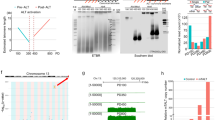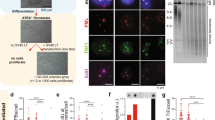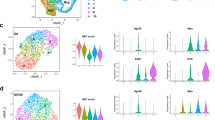Abstract
Telomerase activity and telomere maintenance have been associated with immortality in tumor and embryonic stem cells. Whereas most normal somatic cells are telomerase negative, low levels of this enzyme have been found in adult stem cells from the skin, gut and the hematopoietic system. Here, we show that telomerase activity is not detectable in human mesenchymal stem cells (hMSCs), which have the phenotype SH2+, SH3+, SH4+, CD29+, CD44+, CD14−, CD34− and CD45−, and have the capacity to differentiate into adipocytes, chondrocytes and osteoblasts. These data suggest that hMSCs have a different telomere biology compared to other adult stem cells. Alternatively, true mesenchymal stem cells might be a very rare subpopulation that have a detection level that is below the sensitivity of the TRAP assay.
This is a preview of subscription content, access via your institution
Access options
Subscribe to this journal
Receive 12 print issues and online access
$259.00 per year
only $21.58 per issue
Buy this article
- Purchase on Springer Link
- Instant access to full article PDF
Prices may be subject to local taxes which are calculated during checkout


Similar content being viewed by others
References
Caplan AI, Bruder SP . Mesenchymal stem cells: building blocks for molecular medicine in the 21st century. Trends Mol Med 2001; 7: 259–264.
Caplan AI . Mesenchymal stem cells. J Orthop Res 1991; 9: 641–650.
Prockop DJ . Marrow stromal cells as stem cells for nonhematopoietic tissues. Science 1997; 276: 71–74.
Pittenger MF, Mackay AM, Beck SC, Jaiswal RK, Douglas R, Mosca JD et al. Multilineage potential of adult human mesenchymal stem cells. Science 1999; 284: 143–147.
Deans RJ, Moseley AB . Mesenchymal stem cells: biology and potential clinical uses. Exp Hematol 2000; 28: 875–884.
Colter DC, Class R, DiGirolamo CM, Prockop DJ . Rapid expansion of recycling stem cells in cultures of plastic-adherent cells from human bone marrow. Proc Natl Acad Sci USA 2000; 97: 3213–3218.
Reyes M, Verfaillie CM . Characterization of multipotent adult progenitor cells, a subpopulation of mesenchymal stem cells. Ann NY Acad Sci 2001; 938: 231–233; discussion 233–235.
Jiang Y, Jahagirdar BN, Reinhardt RL, Schwartz RE, Keene CD, Ortiz-Gonzalez XR et al. Pluripotency of mesenchymal stem cells derived from adult marrow. Nature 2002; 418: 41–49.
Collins K . Mammalian telomeres and telomerase. Curr Opin Cell Biol 2000; 12: 378–383.
Harley CB, Futcher AB, Greider CW . Telomeres shorten during ageing of human fibroblasts. Nature 1990; 345: 458–460.
Allsopp RC, Chang E, Kashefi-Aazam M, Rogaev EI, Piatyszek MA, Shay JW et al. Telomere shortening is associated with cell division in vitro and in vivo. Exp Cell Res 1995; 220: 194–200.
Bodnar AG, Ouellette M, Frolkis M, Holt SE, Chiu CP, Morin GB et al. Extension of life-span by introduction of telomerase into normal human cells. Science 1998; 279: 349–352.
Martens UM, Chavez EA, Poon SS, Schmoor C, Lansdorp PM . Accumulation of short telomeres in human fibroblasts prior to replicative senescence. Exp Cell Res 2000; 256: 291–299.
Kim NW, Piatyszek MA, Prowse KR, Harley CB, West MD, Ho PL et al. Specific association of human telomerase activity with immortal cells and cancer. Science 1994; 266: 2011–2015.
Thomson JA, Itskovitz-Eldor J, Shapiro SS, Waknitz MA, Swiergiel JJ, Marshall VS et al. Embryonic stem cell lines derived from human blastocysts. Science 1998; 282: 1145–1147.
Amit M, Carpenter MK, Inokuma MS, Chiu CP, Harris CP, Waknitz MA et al. Clonally derived human embryonic stem cell lines maintain pluripotency and proliferative potential for prolonged periods of culture. Dev Biol 2000; 227: 271–278.
Harle-Bachor C, Boukamp P . Telomerase activity in the regenerative basal layer of the epidermis in human skin and in immortal and carcinoma-derived skin keratinocytes. Proc Natl Acad Sci USA 1996; 93: 6476–6481.
Kolquist KA, Ellisen LW, Counter CM, Meyerson M, Tan LK, Weinberg RA et al. Expression of TERT in early premalignant lesions and a subset of cells in normal tissues. Nat Genet 1998; 19: 182–186.
Chiu CP, Dragowska W, Kim NW, Vaziri H, Yui J, Thomas TE et al. Differential expression of telomerase activity in hematopoietic progenitors from adult human bone marrow. Stem Cells 1996; 14: 239–248.
Engelhardt M, Kumar R, Albanell J, Pettengell R, Han W, Moore MA . Telomerase regulation, cell cycle, and telomere stability in primitive hematopoietic cells. Blood 1997; 90: 182–193.
Morrison SJ, Prowse KR, Ho P, Weissman IL . Telomerase activity in hematopoietic cells is associated with self-renewal potential. Immunity 1996; 5: 207–216.
Colter DC, Sekiya I, Prockop DJ . Identification of a subpopulation of rapidly self-renewing and multipotential adult stem cells in colonies of human marrow stromal cells. Proc Natl Acad Sci USA 2001; 98: 7841–7845.
Sawant SG, Gregoire V, Dhar S, Umbricht CB, Cvilic S, Sukumar S et al. Telomerase activity as a measure for monitoring radiocurability of tumor cells. FASEB J 1999; 13: 1047–1054.
Bruder SP, Jaiswal N, Haynesworth SE . Growth kinetics, self-renewal, and the osteogenic potential of purified human mesenchymal stem cells during extensive subcultivation and following cryopreservation. J Cell Biochem 1997; 64: 278–294.
Reyes M, Lund T, Lenvik T, Aguiar D, Koodie L, Verfaillie CM . Purification and ex vivo expansion of postnatal human marrow mesodermal progenitor cells. Blood 2001; 98: 2615–2625.
Shi S, Gronthos S, Chen S, Reddi A, Counter CM, Robey PG et al. Bone formation by human postnatal bone marrow stromal stem cells is enhanced by telomerase expression. Nat Biotechnol 2002; 20: 587–591.
Simonsen JL, Rosada C, Serakinci N, Justesen J, Stenderup K, Rattan SI et al. Telomerase expression extends the proliferative life-span and maintains the osteogenic potential of human bone marrow stromal cells. Nat Biotechnol 2002; 20: 592–596.
Acknowledgements
We thank Ilona Skatulla for excellent technical assistance and Professor R Mertelsmann for his continuous support. This work was supported by grants from the Deutsche Forschungsgemeinschaft (SFB 364) and from the 5th Framework Programme of the European Union (QLG1-CT-1999-01341).
Author information
Authors and Affiliations
Rights and permissions
About this article
Cite this article
Zimmermann, S., Voss, M., Kaiser, S. et al. Lack of telomerase activity in human mesenchymal stem cells. Leukemia 17, 1146–1149 (2003). https://doi.org/10.1038/sj.leu.2402962
Received:
Accepted:
Published:
Issue Date:
DOI: https://doi.org/10.1038/sj.leu.2402962
Keywords
This article is cited by
-
TERC haploid cell reprogramming: a novel therapeutic strategy for aplastic anemia
Molecular Medicine (2023)
-
Enhanced cardiac repair by telomerase reverse transcriptase over-expression in human cardiac mesenchymal stromal cells
Scientific Reports (2019)
-
Biological functions of mesenchymal stem cells and clinical implications
Cellular and Molecular Life Sciences (2019)
-
Comprehensive characterization of chorionic villi-derived mesenchymal stromal cells from human placenta
Stem Cell Research & Therapy (2018)
-
Characterization of embryonic stem cell-differentiated fibroblasts as mesenchymal stem cells with robust expansion capacity and attenuated innate immunity
Stem Cell Research & Therapy (2018)



